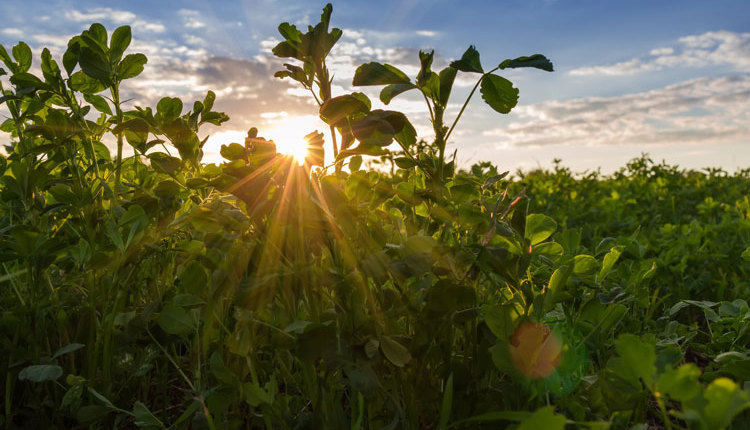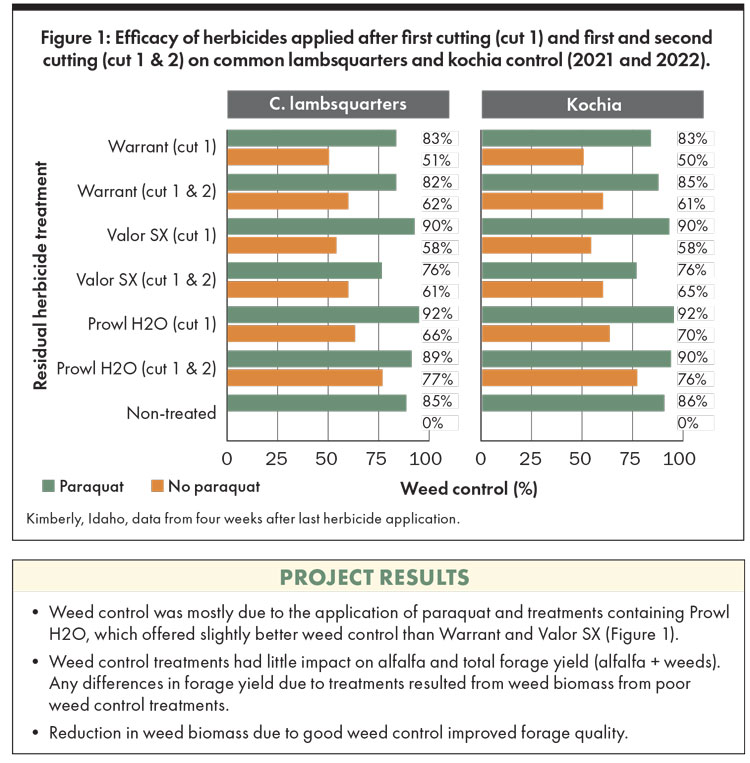
Residual herbicides may help alfalfa growers in their fight against herbicide-resistant weeds such as pigweeds and kochia, according to recent Alfalfa Checkoff-funded research.
As weeds gain resistance to traditional ALS-inhibiting herbicides for conventional alfalfa and glyphosate in Roundup Ready alfalfa, growers have few weed control options. Albert Adjesiwor, University of Idaho, and Nevin Lawrence, University of Nebraska-Lincoln, decided to study the effects of residual herbicides for alfalfa to help control resistant weeds between cuttings and reduce weed impacts on yield and quality.
“Resistant weeds are dramatically changing herbicide programs in various crops,” Adjesiwor said. “In row crops, many farmers have shifted to using overlapping residual herbicide programs to control resistant weeds as effective herbicide options become scarce. As more weeds develop resistance to commonly used alfalfa herbicides, it is important to evaluate the efficacy of residual herbicides for weed management, especially during the seeding year when alfalfa is most vulnerable to weed competition.”
The researchers’ goal was to gather information on optimal timing of residual herbicides in alfalfa and determine whether they have any negative impact on alfalfa hay yield and quality. The 2021 and 2022 study first looked at forage yield and quality as influenced by weed control treatments in irrigated conventional alfalfa seeded in Idaho and Nebraska. The foliar herbicide paraquat and residual herbicides pendimethalin (Prowl H2O), acetochlor (Warrant), and flumioxazin (Valor SX), all labeled for use in alfalfa, were applied. Herbicide treatments included: Paraquat applied after first cutting; Prowl H2O after first cutting; Prowl H2O after first and second cutting; Warrant after first cutting; Warrant after first and second cutting; Valor SX after first cutting; Valor SX after first and second cutting.
Figure 1 shows the effect of stands treated with residuals (no Paraquat) versus stands treated with Paraquat and residuals and their effect on lambsquarters and kochia in Idaho. At Nebraska, lambsquarters and Palmer amaranth were studied.

The research showed the addition of residual herbicides, especially Prowl H2O and Valor SX, are promising for the control of ALS- and glyphosate-resistant weeds such as kochia and Palmer amaranth in alfalfa. However, weed control was primarily due to the application of paraquat. Treatments containing Prowl H2O resulted in slightly better weed control than Valor SX and Warrant.
“It’s important to note that, overall, none of the residual herbicides negatively impacted alfalfa hay yield or quality,” Adjesiwor stressed. “Ironically, one of the biggest challenges we had in completing this research was trying to keep weed pressure down to enable successful stand establishment since no weed control treatments were applied until after the first cutting.”
The second part of the study examined weed biomass and forage quality using herbicides chosen for providing poor to excellent control of weeds common at the experimental sites. Treatments were pre-emergence incorporated, early postemergence, and postemergence herbicide applications. Nutritive value analyses were taken of each weed species within stands, including kochia, common lambsquarters, field bindweed, shepherd’s purse, and green foxtail. Some weeds provided similar amounts of crude protein or neutral detergent fiber to alfalfa; others reduced forage quality.
Adjesiwor also noted that forage quality in stands with heavy weed pressure can be improved with effective weed control that reduces weed biomass.
He is currently working on a NAFA-funded project evaluating alternatives to paraquat for weed burndown in alfalfa, which is showing promise. Adjesiwor is also helping develop a multi-state project to assess impacts of weed control practices on weed density and biomass, alfalfa yield and quality, and animal performance (milk production). Its purpose is to develop guidelines for ecological weed management and sustainable alfalfa production.

